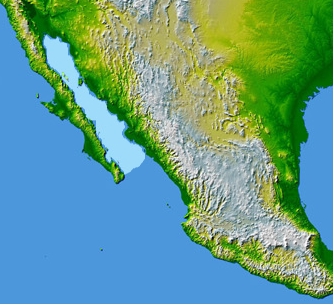
Gulf of California
The Gulf of California (Spanish: Golfo de California), also known as the Sea of Cortés (Mar de Cortés) or Sea of Cortez, or less commonly as the Vermilion Sea (Mar Vermejo), is a marginal sea of the Pacific Ocean that separates the Baja California peninsula from the Mexican mainland. It is bordered by the states of Baja California, Baja California Sur, Sonora, and Sinaloa with a coastline of approximately 4,000 km (2,500 mi). Rivers that flow into the Gulf of California include the Colorado, Fuerte, Mayo, Sinaloa, Sonora, and the Yaqui. The surface of the gulf is about 160,000 km2 (62,000 sq mi). Maximum depths exceed 3,000 meters (9,800 ft) because of the complex geology, linked to plate tectonics.[3]
"Sea of Cortez" redirects here. For the John Steinbeck book, see The Log from the Sea of Cortez.Gulf of California
Pacific Ocean
1,126 km (700 mi)
48–241 km (30–150 mi)
160,000 km2 (62,000 sq mi)
37
Islands and Protected Areas of the Gulf of California
Natural
vii, ix, x
2005
2019–present[2]
The gulf is thought to be one of the most diverse seas on Earth and is home to more than 5,000 species of micro-invertebrates.[4] Parts of the Gulf of California are a UNESCO World Heritage Site.
Geography[edit]
History[edit]
The marine expeditions of Fortún Ximénez,[5] Hernán Cortés,[6] Juan Rodríguez Cabrillo,[7] Francisco de Ulloa,[8] Hernando de Alarcón, Captain Francisco de Lucenilla,[9] and Sebastián Vizcaíno document its earliest record.[10] Juan de Oñate reached the gulf overland in 1605 by following the Colorado River.[11] In the 19th century Duflot de Mofras of France and C.H. Gilbert of the United States Fish Commission visited the area.[12][13]
Area[edit]
The International Hydrographic Organization defines the southern limit of the gulf as: "A line joining Piaxtla Point (latitude 23°38'N) on the west coast of the mainland of Mexico, and the southern extreme of Lower California".[14]
The gulf is 1,126 km (700 mi) long and 48–241 km (30–150 mi) wide, with an area of 177,000 km2 (68,000 sq mi), a mean depth of 818.08 m (2,684.0 ft), and a volume of 145,000 km3 (35,000 cu mi).[1]
The Gulf of California includes three faunal regions:
Climate[edit]
Ocean[edit]
The depth of the water helps to determine its temperature. For example, shallow depths are directly influenced by the local temperature of the air, while deeper waters are less susceptible to changes in air temperature.[3] The temperature of the water in the gulf generally experiences lows of 16 °C (61 °F) in winter and highs of 24 °C (75 °F) in summer. But temperatures can vary greatly in the gulf, and the water is almost always warmer by the coast than the open ocean. For example, the waters surrounding La Paz reach 30 °C (86 °F) in August, while the waters in neighboring city Cabo San Lucas, only reach 26 °C (79 °F).[1][21][22][23]
Occasionally, the northern gulf will go through significantly cold winters. The water in the northern gulf can sometimes drop below 8 °C (46 °F), which can lead to a large die-off of marine organisms. The animals most susceptible to the large decrease in water temperature include macroscopic algae and plankton.[3]